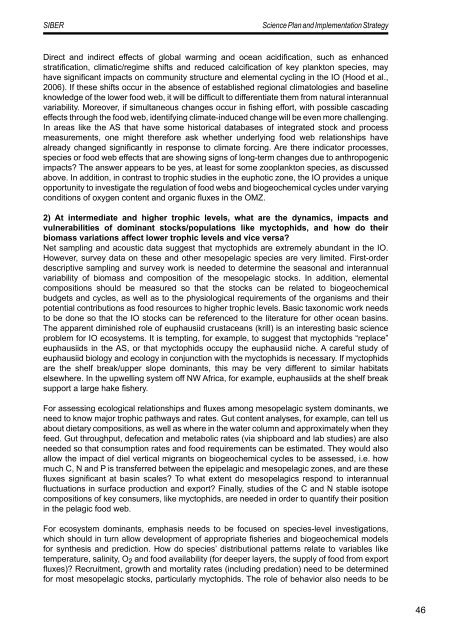SIBER SPIS sept 2011.pdf - IMBER
SIBER SPIS sept 2011.pdf - IMBER
SIBER SPIS sept 2011.pdf - IMBER
You also want an ePaper? Increase the reach of your titles
YUMPU automatically turns print PDFs into web optimized ePapers that Google loves.
<strong>SIBER</strong><br />
Science Plan and Implementation Strategy<br />
Direct and indirect effects of global warming and ocean acidification, such as enhanced<br />
stratification, climatic/regime shifts and reduced calcification of key plankton species, may<br />
have significant impacts on community structure and elemental cycling in the IO (Hood et al.,<br />
2006). If these shifts occur in the absence of established regional climatologies and baseline<br />
knowledge of the lower food web, it will be difficult to differentiate them from natural interannual<br />
variability. Moreover, if simultaneous changes occur in fishing effort, with possible cascading<br />
effects through the food web, identifying climate-induced change will be even more challenging.<br />
In areas like the AS that have some historical databases of integrated stock and process<br />
measurements, one might therefore ask whether underlying food web relationships have<br />
already changed significantly in response to climate forcing. Are there indicator processes,<br />
species or food web effects that are showing signs of long-term changes due to anthropogenic<br />
impacts The answer appears to be yes, at least for some zooplankton species, as discussed<br />
above. In addition, in contrast to trophic studies in the euphotic zone, the IO provides a unique<br />
opportunity to investigate the regulation of food webs and biogeochemical cycles under varying<br />
conditions of oxygen content and organic fluxes in the OMZ.<br />
2) At intermediate and higher trophic levels, what are the dynamics, impacts and<br />
vulnerabilities of dominant stocks/populations like myctophids, and how do their<br />
biomass variations affect lower trophic levels and vice versa<br />
Net sampling and acoustic data suggest that myctophids are extremely abundant in the IO.<br />
However, survey data on these and other mesopelagic species are very limited. First-order<br />
descriptive sampling and survey work is needed to determine the seasonal and interannual<br />
variability of biomass and composition of the mesopelagic stocks. In addition, elemental<br />
compositions should be measured so that the stocks can be related to biogeochemical<br />
budgets and cycles, as well as to the physiological requirements of the organisms and their<br />
potential contributions as food resources to higher trophic levels. Basic taxonomic work needs<br />
to be done so that the IO stocks can be referenced to the literature for other ocean basins.<br />
The apparent diminished role of euphausiid crustaceans (krill) is an interesting basic science<br />
problem for IO ecosystems. It is tempting, for example, to suggest that myctophids “replace”<br />
euphausiids in the AS, or that myctophids occupy the euphausiid niche. A careful study of<br />
euphausiid biology and ecology in conjunction with the myctophids is necessary. If myctophids<br />
are the shelf break/upper slope dominants, this may be very different to similar habitats<br />
elsewhere. In the upwelling system off NW Africa, for example, euphausiids at the shelf break<br />
support a large hake fishery.<br />
For assessing ecological relationships and fluxes among mesopelagic system dominants, we<br />
need to know major trophic pathways and rates. Gut content analyses, for example, can tell us<br />
about dietary compositions, as well as where in the water column and approximately when they<br />
feed. Gut throughput, defecation and metabolic rates (via shipboard and lab studies) are also<br />
needed so that consumption rates and food requirements can be estimated. They would also<br />
allow the impact of diel vertical migrants on biogeochemical cycles to be assessed, i.e. how<br />
much C, N and P is transferred between the epipelagic and mesopelagic zones, and are these<br />
fluxes significant at basin scales To what extent do mesopelagics respond to interannual<br />
fluctuations in surface production and export Finally, studies of the C and N stable isotope<br />
compositions of key consumers, like myctophids, are needed in order to quantify their position<br />
in the pelagic food web.<br />
For ecosystem dominants, emphasis needs to be focused on species-level investigations,<br />
which should in turn allow development of appropriate fisheries and biogeochemical models<br />
for synthesis and prediction. How do species’ distributional patterns relate to variables like<br />
temperature, salinity, O 2 and food availability (for deeper layers, the supply of food from export<br />
fluxes) Recruitment, growth and mortality rates (including predation) need to be determined<br />
for most mesopelagic stocks, particularly myctophids. The role of behavior also needs to be<br />
46












